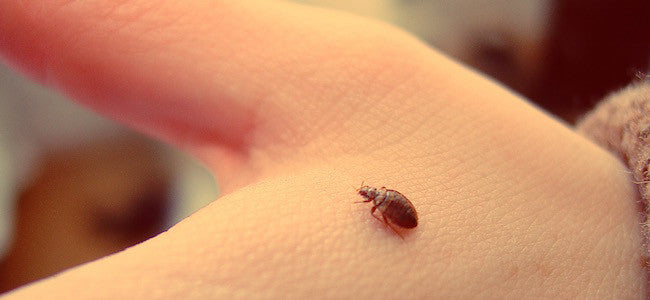5 Steps to Eliminate Bed Bugs from Your Life

Anyone who has ever dealt with bed bugs is aware of how hard it is to eradicate those buggers. They quickly acclimate to new temperatures and survive up to a year without a meal. Adult bed bugs are reddish-brown and around ½ cm long. Young bed bugs (nymphs) are whitish-yellow and 1-4 mm long. The female can lay up to 500 eggs in her life time, usually 1-3 per day.
Even though bed bugs do not spread any infections, their bites can cause allergic reactions, not to mention stress. In the old days, people used DDT (dichlorodiphenyltrichloroethane) to get rid of bed bugs – before it was found to be cancerous. Fortunately, new solutions to eliminating these creatures have been found – these involve a systematic and multi-level approach. Here are our research-backed steps to eliminate bed bugs from your life.
1. Identify and localize your problem
Before going on any bed bug squashing mission, identify and verify that bed bugs are in fact your enemies. Many bugs can resemble bed bugs. If you start experimenting with possible solutions on your own without knowing for sure, you might only worsen the problem and scatter the bugs to other areas in your home.
Since bed bugs are small and hard to spot, try using a magnifying glass and flashlight. Check dark and isolated places. Even though initially bed bugs like to stay near their food source, which is around the bed, they can eventually wander off to other areas in your home. Bed bugs can flatten their bodies, which means they can easily sneak through cracks and crevices.
Make sure to check the creases and seams of your sofa. The smaller and tighter the location, the higher the odds that bed bugs will be hiding in it. Even if you don’t find them, spots of fecal waste are a giveaway that your house is infested with bed bugs.
2. Prepare the area
Throw away everything you do not need.
Next, move the bed, mattress, closet and everything else away from the corners and the walls, toward the center of the room. Dismantle the bed, empty the drawers and turn them upside down in order to expose potential hiding places. Seal any holes or cracks to prevent the bugs from spreading.
Be careful how you discard infested items. If you are throwing away your mattress, label it as bed bug infested to prevent someone else from taking it before the collection truck does. Also, be careful how you take it out from your home. The best way is to wrap it in plastic so that the bugs do not start falling off while you are dragging it out of your house. Make sure to completely eliminate bed bugs first before you start bringing in new furniture.
3. Start the treatment
Call a pest control provider. It might seem expensive at first, but it’s much cheaper than guessing and dragging out the problem. You will need professional help. Afterwards, when the initial phase is over, you can simply follow the pest control officer’s instructions to continue removal.
Use EPA-approved insecticides intended for indoor use. Check the US Environmental Protection Agency website or consult a professional on which product to use. Using the wrong insecticides can have serious negative health consequences. After applying the insecticides, ventilate the room for several hours before entering.
Apply pesticides on cracks and crevices, after you’ve had a chance to vacuum the areas. Dust pesticides last longer while aerosol sprays can reach into more tricky areas, so use a combination of the two. If the bed bugs are still there after two weeks, and they probably will be since the leftover eggs will hatch in the meantime, repeat the process. Normally, the process needs repeating every 2 weeks.
Use a natural dehydrating substance, such as Food Grade Diatomaceous Earth, which is environmentally friendly and harmless to children and pets. Put it into a duster and spray it on items in your home. Use a brush to help you distribute it. Treat the bed frame from all sides with both dust and aerosol — but not at the same time. Spray all sides of the bed, the footboard, headboard, chairs, around and inside the closets, doors, windows and cabinets. Spray the lower parts of beds, closets and cabinets where they touch the floor, since these are the riskier areas.
Crystal silica gel is a cheaper variant of the bed bug dust. You can use it by grinding and spraying it on your mattress and other bed bug prone locations. It will stick to the surface and dehydrate and kill the bugs. Make sure to avoid inhaling this.
Extreme temperatures can kill beg bugs. Put items such as shoes, jewelry, and your kid’s toys in the freezer, set it to 0 °F and keep them inside for at least 4 days. Another option is to put the items in a hot dryer at 120 °F for 15 minutes. Do not try to kill the bugs by heating or cooling your entire home. That won’t work.
In-home heat tent treatment kills the bugs by exposing them to high temperatures. Simply put your bed, sofa, or any other infested items inside. It’s much better to call a professional rather than attempting to do this on your own. Although this treatment is one of the more expensive options, it is cheaper than throwing away half of your belongings.
Steam kills bed bugs and eggs. You can buy a steamer or make one by adding a tube onto your electric kettle. Then spray the steam at all vulnerable surfaces, such as carpets, cracks in the wall, etc.
Use tea-tree oil. This oil can get rid of bedbugs. Mix it with water and spray the concoction all over your apartment, focusing on the most exposed areas around the bed.
Do not use foggers. This will only scatter the bed bugs and make things worse.
Bed bug pheromone is the future. The latest research on bedbugs has managed to extract the bed bug pheromone and use it to attract the bugs. This special mixture also contains histamine, which then paralyzes the bugs. Although still commercially unavailable, this mixture looks very promising for future battles.
4. Clean like you’ve never cleaned before
Detailed systematic cleaning is the key. Wash all your clothes, blankets, bed linen, teddy bears, even the laundry bag, at 120 °F minimum. What you cannot wash, heat in a hot dryer or seal in plastic bags and store for a year, as this is how long it takes for the bed bugs to die of starvation. Thoroughly scrub infested surfaces to remove eggs.
Seal the cleaned items in plastic bags and be careful not to mix them with potentially infested items.
Vacuum from top to bottom. Be particularly thorough with seams on the mattress, edges of carpets, folds in the sofa, upholstered furniture, children’s toys, baseboards, buttons, etc. Use vacuuming attachments for better reach and for scraping the surface as bugs can cling on. Avoid brush attachments since bugs can stick to them and spread to other places. Immediately dispose of the trash in a sealed bag.
5. Measures of prevention
Be wary of second-hand furniture. Inspect carefully before bringing it into your apartment. Pay particular attention to bed frames, mattresses and upholstery.
Be cautious when travelling. Again, inspect your bed space, check around the footboard, headboard and mattress seams for brown spots. Avoid leaving your luggage on the floor, put it on an elevated area instead. When you come back home, vacuum your luggage and wash your things as soon as possible.
Public workers such as public health home visitors and TV technicians can be a source of infestation too. This does not mean, of course, that you should kick them out of your home for no reason. However, this information can help early detection and intervention.
What’s Next?
Do you know someone who would benefit from these tips? Share it with them by clicking on the social icons below.Sources:
http://www.npmapestworld.org/events/documents/HARLANBdBgsBiolBehavrPstWrldEast.pdf
http://bedbugger.com/faqs/
http://www.wikihow.com/Get-Rid-of-Bed-Bugs
http://cfpub.epa.gov/oppref/bedbug/
http://www.bedbugcentral.com/bedbugs101/what-should-i-do-my-bed
http://emergency.cdc.gov/han/han00336.asp






